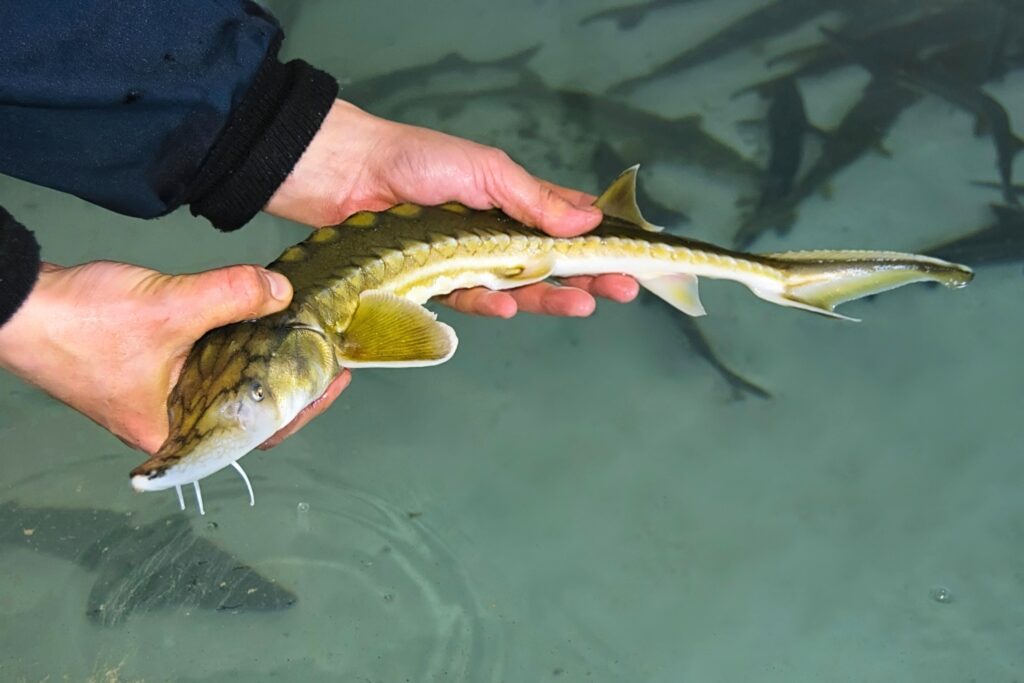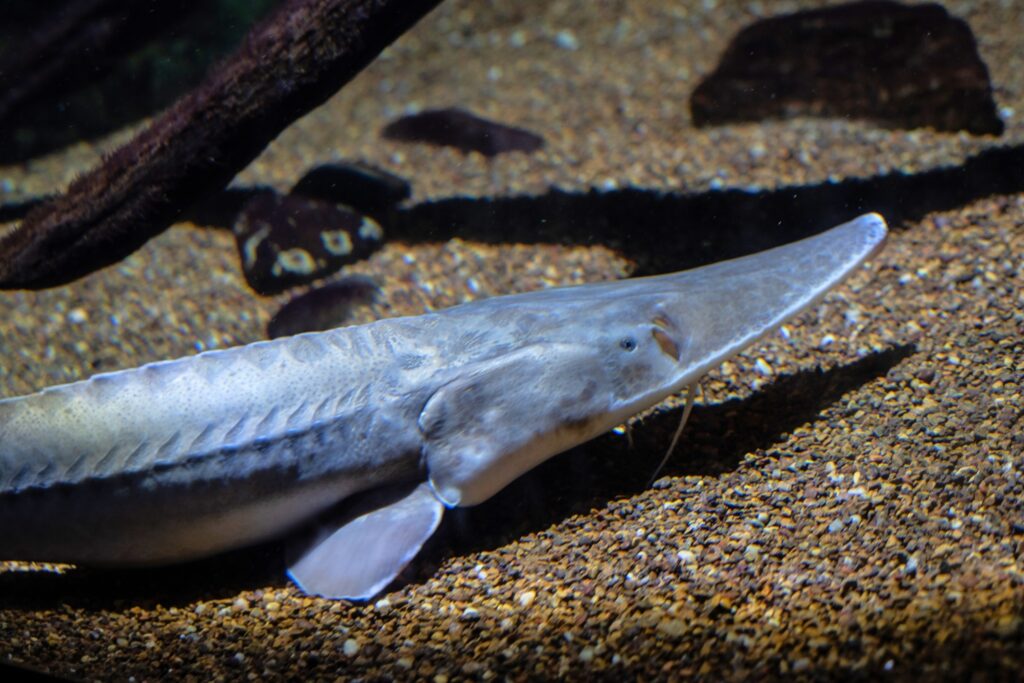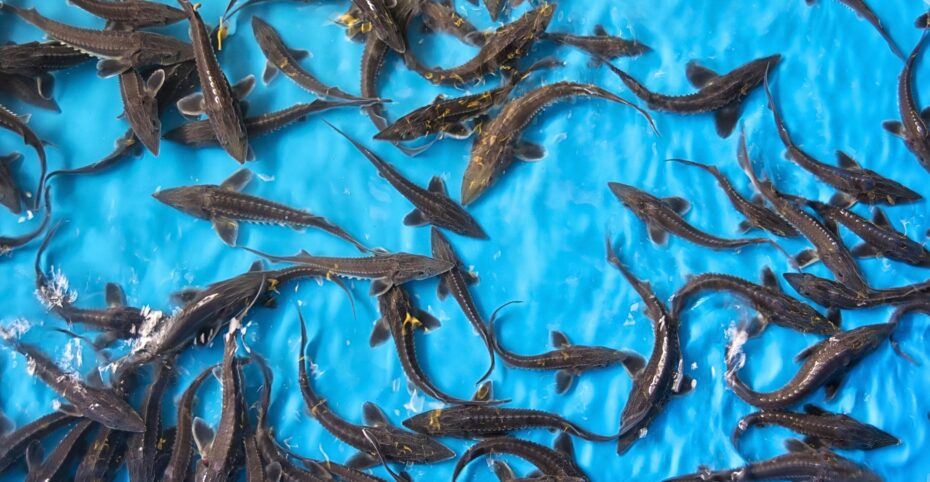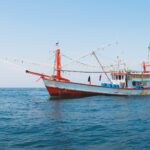What does the sturgeon conservation status look like in 2024? It varies on the geographical region, sturgeon species, and their subpopulations. Some sturgeon species are at higher risk of extinction than others due to various factors, like government regulations, climate change, overfishing, and pollution.
While we can’t list every sturgeon conservation group and effort as many exist, here are the most recent and significant changes.
Crucial Sturgeon Conservation Status Metrics & Measures to Know in 2024

Various legal and non-profit measures are in place to conserve sturgeon globally, including:
- Banned fishing and harvesting locations in critically endangered habitats
- International cooperation in water border protection in high-risk habitats
- Volunteer groups lobbying for additional legislation to protect sturgeon and clean wild habitats
Although sturgeon conservation is making meaningful changes, like increasing population sizes and restoring wild habitats, more must be done. Threats still remain imminent, such as poaching in banned fishing locations, channelization disrupting migration/spawning routes, and unsustainable sturgeon caviar farm practices.
Learn more about the current sturgeon conservation status, progress, and impacts on current populations.
All Remaining Sturgeon Species Risk Extinction
According to the World Wildlife Foundation (WWF), sturgeon fish are the most endangered species group in the world, with all remaining species at risk of extinction, regardless of their conservation status.
While some subpopulations and regions differ in endangerment risks, we must remain vigilant in monitoring and improving sturgeon conservation efforts to prevent them from extinction.
Below is a sturgeon endangered species list with each of their conversation statuses.
| STURGEON SPECIES | STURGEON CONSERVATION STATUS |
| Alabama Sturgeon | Critically Endangered & Population Decreasing |
| Adriatic Sturgeon | Critically Endangered & Population Increasing |
| Amur Sturgeon | Critically Endangered & Population Decreasing |
| Atlantic Sturgeon | Vulnerable & Population Increasing |
| Amu Darya Shovelnose Sturgeon | Critically Endangered & Population Decreasing |
| Beluga Sturgeon (Huso Huso) | Critically Endangered, Extinct in the Adriatic, & Population Decreasing |
| Chinese Paddlefish | Extinct |
| Chinese Sturgeon | Critically Endangered & Population Decreasing |
| Danube (Russian) Sturgeon | Critically Endangered & Population Decreasing |
| European Atlantic Sturgeon | Critically Endangered & Population Decreasing |
| Green Sturgeon | Endangered & Unknown Population Growth |
| Gulf Sturgeon | Vulnerable & Population Decreasing |
| Kaluga Sturgeon | Critically Endangered & Population Decreasing |
| Lake Sturgeon | Stable to Vulnerable Geographical Regions/Population Growths |
| Paddlefish | Vulnerable to Extinct Geographical Regions/Population Growths |
| Pallid Sturgeon | Critically Endangered & Population Decreasing |
| Persian Sturgeon | Critically Endangered & Population Decreasing |
| Sakhalin Sturgeon | Critically Endangered & Population Decreasing |
| Ship Sturgeon | Critically Endangered, Regional Extinction in the Dabune, |
| Shortnose Sturgeon | Vulnerable & Stable Population |
| Shovelnose Sturgeon | Vulnerable & Stable Population |
| Siberian Sturgeon | Critically Endangered & Population Decreasing |
| Stellate Sturgeon | Critically Endangered & Population Decreasing |
| Sterlet | Endangered & Population Decreasing |
| Syr Darya Shovelnose Sturgeon | Critically Endangered (Possibly Extinct) & Population Decreasing |
White Sturgeon | Stable to Critically Endangered Subpopulations/Population Growths |
| Yangtze Sturgeon | Extinct in the Wild & Unknown Population Growth |
Source: World Wildlife Foundation & IUCN Red List of Threatened Species
North American Lake Surgeon Recently Remain Off the Endangered List
The U.S. Fish and Wildlife Service (FWS) recently decided lake sturgeon can remain off the endangered species list due to steady population growth from conservation. Lake sturgeon are categorized as Stable with various recovery and regulation protections demonstrating that most populations are increasing.
However, the WWF states this species has a history of rapid population declines, with adult sturgeon at an all-time low. Therefore, lake sturgeon populations must be carefully monitored to prevent an endangered status.
The majority of lake sturgeon habitats are in North America, with progressing sturgeon conservation efforts. The U.S. and Canada’s northern water borders have heavily regulated sports fisheries. Canada also monitors and manages their smaller commercial fisheries in the Ontario and Quebec provinces.
Missouri Department of Conservation Makes Promising Restock Measures Lake & Pallid Sturgeon

Lake sturgeon located in the Mississippi River and Gulf of Mexico regions are considered Vulnerable due to a lack of population management, restoration, and water development.
The WWF states lake sturgeon stock output levels are stable with extensive migrations reported, but population sizes are still small compared to the late 1800s. White sturgeon fishing is also banned in this region from irreversible habitat degradation.
We remain hopeful for this species region group because the Missouri Department of Conservation (MDC) shows promising restock measures with cultured fish for lake and pallid sturgeon. MDC restocked more than 200 federally endangered pallid sturgeon and restocked 6,000 to 10,000 juvenile lake sturgeon annually.
However, the MDC program must be consistently tracked as the IUCN states pallid sturgeon are critically endangered, with population trends decreasing.
California Reduces North American West Coast White Sturgeon Harvests
The State of California is strengthening conservation regulations for North American West Coast white sturgeon by reducing harvesting thresholds for the 2023 to 2024 fishing season.
California currently considers white sturgeon a species of Special Concern, even though they’re categorized as Stable by the IUCN. Catch and release fishing is still legally allowed with a valid sturgeon report card per their state regulations.
However, white sturgeon subpopulations have varying degrees of conservation statuses per the WWF:
- North American West Coast: Stable
- Nechako River: 50% extinction risk in 20-30 years if current population decline rates continue—Critically Endangered
- Upper Columbian River: Shows significant signs of recruitment and recruitment failure—Critically Endangered
- Upper Fraser River: No more than 250 adults remaining with a restricted population range—Endangered
- Fraser Regional: Rapid population decline Since the 1980s—Vulnerable
Oregon & Washington Stops Fishing Recommendations for White Sturgeon in the Lower Columbia River
The states of Oregon and Washington recently stopped recommending recreational and commercial fishing white sturgeon in the lower Columbia River. They enacted this caution due to the low juvenile survival and recruitment rates. They still allow catch-and-release fishing.
Sturgeon Conservation Status FAQs
Are Sturgeon On the Endangered Species List?
Not all sturgeon species are classified as Endangered. Some regions and subpopulations range from Stable to Critically Endangered and Extinct.
How Many Sturgeon Are Left in the World?
Only 26 remaining sturgeon species (two-thirds) currently exist, as one-third are extinct.
Why Are Sturgeon Endangered?
While endangered statuses differ for various sturgeon species, regions, and subpopulations, they all face the risk of extinction. Reasons include climate change, overharvesting, illegal fishing, pollution, and disruptive water developments like hydropower dams.
Strengthen the Current Sturgeon Conservation Status with SIAA
While most population growth trends are decreasing, there’s still time to save this vital fish species and revitalize sturgeon population sizes.
At SIAA, our causes include modernizing the Endangered Species Act to strengthen existing sturgeon conservation regulations. The FWS currently doesn’t categorize captive and wild sturgeon populations separately, resulting in inaccurate endangerment statuses and how commercialization legally harvests them—including high-risk habitats.
And anyone can become involved to make a difference. Your support helps our critical initiatives to protect sturgeon and aquatic ecosystems effectively. Our mission is to promote stronger caviar industry sustainability and sturgeon conservation globally.
Let’s safeguard the sturgeon together. Become an SIAA member or donate today.





